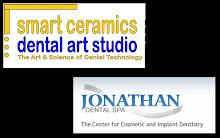Upgrading your dentures
Millions of people are missing most or all of their teeth. For these people, a denture replacement solution that eliminates the need for denture adhesives might mean a new level comfort and ease in their life. Nobel Biocare denture replacement alternatives use dental implants for support, thereby removing the need for the use of messy and unreliable denture adhesives. Denture replacement solutions can even make sore gums obsolete.
Dental implants provide the foundation for our dental replacement alternatives. The use of dental implants can return the look and function that your current dentures and denture adhesives probably aren’t providing. Dental implants have a forty-year history of success stories using dental implants and leads the dental implant market.
If you’re in need of denture repair, or if you’re simply tired of wearing your dentures, consider our denture replacement alternatives and leave your denture adhesives behind. Call us @ the Jonathan Dental Spa 973-423-4460
It’s time to say goodbye to your denture adhesives.
Permanent Dentures
If you’re tired of your current dentures moving around in your mouth, and think denture adhesive is bothersome, our denture replacement solution may be right for you.
A fixed denture replacement solution consists of a dental implant bridge (sometimes called permanent dentures) that is supported by four or more dental implants. By using dental implants to secure the permanent dentures, the need for denture adhesive is a thing of the past. Because the dental implants function like the natural roots, the permanent dentures will feel very much like your natural teeth did.
Steps to getting that beautiful smile
Permanent dentures procedure
--------------------------------------------------------------------------------
Say goodbye to denture adhesives and powders by getting a permanent denture secured to dental implants.
Click on each of the steps below to find out how you can get a new beautiful smile with a fixed permanent denture solution. If you have specific questions, we recommend you discuss them with your dentist.
View procedure flash version
1
Examination
The first step is to visit your dentist for an examination and to discuss your individual solution options.
2
Preparation
The second step is the preparation phase, where your dentist will plan the next steps of the process. Here, your dentist is gaining insight into how your dental implants will be placed.
3
Implant
This is the step wherein your dentist will place the necessary dental implants in your jaw.
4
Smile
Once your final teeth are placed you’ll have your beautiful new smile.
1
The first step to your new permanent teeth is an examination of your current situation by your dentist. Then, you and your dentist can determine which solution works best for you.
During your examination, you may be presented with the option to follow a conventional process or a state-of-the-art guided process to place your dental implants
The guided process uses a CT scan, or a model of your jawbone, to plan your entire dental procedure before it begins. Keyhole surgery is used to place the dental implant. This minimally invasive technique reduces the healing time traditionally experienced in the conventional process, as well as eliminates the need for stitches, a significant amount of swelling, and much of the discomfort arising when your dental implants are placed using conventional methods.
2
Conventional process
Under the conventional process, your dentist will take x-rays to see how your jawbone looks. Often an impression will be taken of your current teeth and jawbone.
Guided process
Under the guided process, your dentist will map your jawbone or your jaw and teeth will be scanned using computerized tomography (CT) enabling your dentist to plan your entire dental procedure before getting started. From this planning, a guide is created that will help the dentist to place the dental implants into the optimal positions.
At the same time, a laboratory will begin making your final teeth, so they are ready for placement at the same time your dental implants are placed.
3
Conventional Process
Under the conventional process, you’ll undergo the following:
- You’ll receive local anesthesia
- Your dentist will place your dental implants
- Your dentist may place temporary teeth to your dental implants, so you can eat during the healing process
Otherwise, you will wear your denture for some additional time
- An impression to fabricate your new final fixed teeth will be made as soon as the clinical situation allows
Guided Process
Under the keyhole method, you’ll undergo the following:
- You’ll receive local anesthesia
- Using the surgical guide and keyhole surgery, your dentist will then place your dental implants
- Once placed, your dentist will place your (pre-prepared) final permanent dentures
- And you’re done!
4
Conventional Process
- After your dentist has determined that your gums have sufficiently healed you’ll return to have your final permanent dentures placed. Your dentist will ensure that your bite is correct and you’re pleased with the results.







